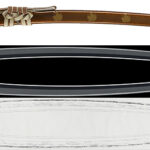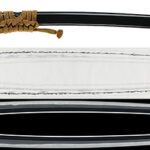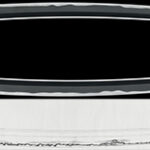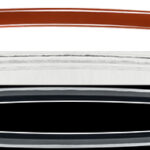Ordering number:AS231887
Katana in Shirasaya (21st NBTHK Juyo Token)
Signature: Mumei (attributed to Aoe)
無銘(青江)
Sayagaki:21st Juyo Token
Aoe, though greatly shortened and unsigned.
The blade length is 2 shaku 2 sun 7 bu, a typical example of this smith’s work.
Inscribed by Kanzan, Showa 50 (1975), midsummer.
At our company, we classify swords into four categories: Saijyo Saku, Jyojyo Saku, Jyo Saku, and Regular Saku, based on the craftsmanship of the swordsmith.
This piece is ranked as Saijyo Saku (top grade) for works attributed to Mumei (Aoe).
The sword has been polished.
Habaki: Single gold-foil habaki.
Blade Length: 69.4 cm (27.32 in)
Curvature: 1.7 cm (0.67 in)
Mekugi Holes: 2
Width at Base (Motohaba): 2.90 cm (1.14 in)
Width at Tip (Sakihaba): 2.20 cm (0.87 in)
Thickness (Kasane): 0.70 cm (0.28 in)
Sword Weight: 660 grams (1.46 lbs)
Era: Late Kamakura to early Nanbokucho period.
This piece is from the late Kamakura period.
Shape:The blade is greatly shortened (O-suriage) and unsigned, with a well-proportioned width.
Both sides of the blade feature a bo-hi (groove), and the deep curvature extends to the tip.
Jigane:The small itame grain is well-forged, showing the characteristic chirimen (crinkled texture) of Aoe steel, with visible utsuri (faint shadow patterns).
Hamon:The nioi-deki suguha (straight temper line) is interspersed with well-formed ko-ashi (small legs), and the boshi (tip) is large, curving back in a komaru shape.
Features:Aoe swords, historically renowned, were produced by a group of swordsmiths based in the Takahashi River region.
Their craftsmanship thrived from the mid-Kamakura period through the Nanbokucho period.
Swords made during the mid-Kamakura period are referred to as Ko-Aoe, while those from the late Kamakura period are known simply as Aoe.
This piece, attributed to Aoe, features a distinct suguha hamon with well-formed ko-ashi, and the boshi extends gracefully with a sharp, crisp suguha.
The jigane is particularly noteworthy, with the distinct chirimen texture, setting it apart from other swordsmiths.
The utsuri is faint but adds to the refined character of the sword, making it a highly valuable piece.
Aoi Art's Comment:
The Aoe school, which developed along the Takahashi River, is known for preserving its characteristic features, including the tightly-formed suguha hamon with a slightly reversed ko-choji-ashi (small clove-shaped legs).
This sword displays subtle utsuri, and the tightly formed hamon exemplifies the distinct qualities of Aoe craftsmanship.
Koshirae:
Tachi koshirae
Tsuba: Shakudo base engraved with patterns, decorated with gold inlay.
Kojiri, Fuchikashira, and other fittings: Shakudo base with gold-inlaid patterns.
Menuki: Iron base engraved with a dragon, decorated with gold inlay on the legs and other details.
Juyo Token from the 21st Session
Accompanied by Aoi Art’s estimation paper.
Comes with a complete oshigata.
Auction Starting Price:3,750,000JPY
Place Bid
Related Items:
 Katana: Nobutsugu(Aoe)(65th NBTHK Juyo Token)
Katana: Nobutsugu(Aoe)(65th NBTHK Juyo Token)
 Katana:Mumei (Aoe)(44th NBTHK Juyo Token)
Katana:Mumei (Aoe)(44th NBTHK Juyo Token)
 Tachi: Aoe Ju Yoshitsugu Saku(31st NBTHK Juyo Token)
Tachi: Aoe Ju Yoshitsugu Saku(31st NBTHK Juyo Token)
 Katana Bizen Osafune (partially cut off) (Masamitsu) Nen 8 Gatsu (partially cut off) (48th NBTHK Juyo Token)
Katana Bizen Osafune (partially cut off) (Masamitsu) Nen 8 Gatsu (partially cut off) (48th NBTHK Juyo Token)
 Katana: Mumei(Unsigned)(Aoe school)(54th NBTHK Juyo Token)
Katana: Mumei(Unsigned)(Aoe school)(54th NBTHK Juyo Token)
 Katana:Signature: Mumei (attributed to Den Cho Aritoshi)(25th NBTHK Juyo Token)
Katana:Signature: Mumei (attributed to Den Cho Aritoshi)(25th NBTHK Juyo Token)







